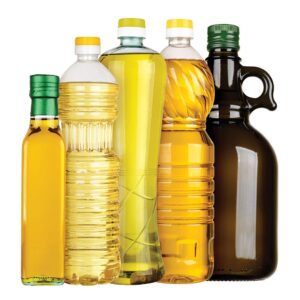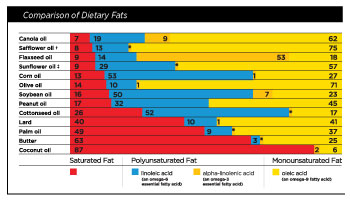What does the fat chart tell us?

The body needs fat, but what kind and how much? The fat chart promoted through CanolaEatWell.com and CanolaInfo.com compares canola oil to olive oil, coconut oil, butter and other fats. Canola Eat Well, CanolaInfo and canola oil processors use these comparisons to promote canola oil as a healthy and versatile choice for dressings, frying and baking.
“The chart uses information that is publicly available from government databases and is a great visual tool to show how canola oil compares to other sources of dietary fat,” says Shaunda Durance-Tod, manager of CanolaInfo for the Canola Council of Canada. “We have found it to be very useful to help both promote canola oil and dispel misinformation about other oils. People are often surprised to learn, for example, that olive oil doesn’t provide very much omega-3.”
The human body requires a diet that includes some fat, especially omega-3 fatty acid, for brain function (the brain is 60 per cent fat), cell structure and the absorption of vitamins. The right fats can also help the body maintain healthy cholesterol levels, which is good for the heart and blood vessels.
Recommendations are to get 20 to 30 per cent of daily calories from fat. Because fat is dense in calories, this amounts to only around 50 grams a day. “Canada’s Food Guide recommends that saturated fat be limited and be replaced with fats like canola oil,” says Lynn Weaver, market development manager for SaskCanola. The American Heart Association goes a step further and recommends a diet where five to six per cent of calories from saturated fat. Its website, heart.org, says “if you need about 2,000 calories a day, no more than 120 of them should come from saturated fat. That’s about 13 grams of saturated fat per day.”
Most plant-based oils are a good way to cut back on saturated fat while still providing the fat required for health.
“The more unsaturated a fatty acid is, the better it is from a nutritional point of view,” says Michael Eskin, professor in the department of food and nutritional sciences in the Faculty of Agriculture and Food at the University of Manitoba.
Health Canada, on its website, says “Unsaturated fats are good for your health. In fact, some are essential to the healthy functioning of the body.”
Fats are made of fatty acids
Canola has, on average, seven per cent saturated fat, 62 per cent monounsaturated fat and 28 per cent polyunsaturated fat. (These numbers vary slightly from hybrid to hybrid, location to location, and year to year.) Within each of these categories are specific fatty acids, which are a carbon chains with hydrogen and oxygen. Fatty acid molecules have a methyl “CH3” at one end, a carboxyl “COOH” at the other end, and a string of CH2s in between.
Saturated fat
Fatty acids with hydrogen atoms filling all available spaces along the carbon chain are “saturated”. They have no carbon double bonds. Palmitic acid is the largest component of canola oil’s saturated fat. It has 16 carbons in the chain and is written as C16:0 – the zero meaning no double bonds. Stearic acid, C18:0, accounts for most of the rest.
Saturated fat molecules are flat, so they stack tightly. “They cuddle up to each other and form a strong crystalline structure that is solid at room temperature,” Eskin says.
Butter and coconut oil, for example, are high in saturated fat.

Monounsaturated fat
Monounsaturated fatty acids have one carbon double bond, which creates a bend in the carbon chain. The most common monounsaturated fat in plant-based oils is omega-9 oleic acid (C18:1). Oleic acid is thought to be good for heart health. Canola oil, like olive oil, has a high content of oleic acid. The term omega, by the way, refers to the position of the first double bond relative to the methyl end of the molecule. With omega-9, the first double bond is nine carbons away from the methyl end.
Polyunsaturated fatty acids
Polyunsaturated fats have two or more carbon double bonds. “With a kink at each double bond, monounsaturated and polyunsaturated fatty acids don’t stack up. They’re more liquid,” Eskin says.
Canola oil includes omega-6 linoleic fatty acid (C18:2) and omega-3 alpha-linolenic fatty acid (C18:3). The body needs to take in omega-3 fatty acid from the diet, making it an essential nutrient. The brain needs omega-3 docosahexaenoic acid (DHA). Fish oil is a good source of DHA. Canola oil’s alpha-linolenic acid (ALA) is a different type of omega-3, which the liver can synthesize to DHA. A new specialty-oil canola, not yet available for production in Canada, produces a plant-based supply of DHA.
Trans fatty acids
The more double-bonds, the higher the rate of oxidation. Oxidation breaks the triglyceride bonds (more on that below), releasing free fatty acids that form off-flavours – often called rancidity. In food service fryers and processed food, oxidation reduces the frying life and shelf life of food. Processors learned to hydrogenate plant-based oils to remove (or partially remove) the double bonds in fatty acid molecules, reducing the rate of oxidation and improving the functionality of plant-based oils.
However, hydrogenation also flipped the carbon bonds, making them “trans” versus “cis”. This variation in the shape made trans fatty acids worse than saturated fats from a health perspective, Eskin says, and countries eventually banned the use of trans fats. Health Canada introduced its ban in 2018.
“Hydrogenated fats were so important for food service, they had to find a replacement,” Eskin says. One pathway was to develop specialty canola oil with 75 per cent oleic acid and only three per cent alpha-linolenic acid. These specialty canola oils from Cargill and Nexera (Corteva) went into food fryers across North America, providing a plant-based oil with long frying life and no trans fats.
Triglycerides
All oils are made up of triglycerides. Crude oil also has free fatty acids, phosphorus, chlorophyll, which are removed in the refining process to get a pure solution of triglycerides. Triglycerides have a glycerol back bone with three fatty acids attached at the carboxyl end “like tines of fork,” Eskin says. Within any litre of canola oil, some triglycerides will have three oleic fatty acids, some will have combinations of fatty acids.
Breaking apart of triglycerides through oxidation will happen over time, and is accelerated with heat. Canola that heats in the bin, for example, will have higher levels of free fatty acids. Once triglycerides are eaten, the human body has enzymes to break them apart so it can use individual fatty acids as needed.
Health Claims
Many plant-based oils, including canola, have qualified health claims. Health Canada approved a health claim for vegetable oils, providing approved wording for use on product packaging. Here is a sample from
its website:
“Replacing saturated fats with polyunsaturated and monounsaturated fats from vegetable oils helps lower cholesterol. Two teaspoons (10 mL) of this blend of corn and canola oil contains 84 per cent less saturated fat than two teaspoons (10 g) of butter.”
The U.S. Food and Drug Administration (FDA) approved in 2006 the following health claim for canola oil:
“Limited and not conclusive scientific evidence suggests that eating about one and a half tablespoons (19 grams) of canola oil daily may reduce the risk of coronary heart disease due to the unsaturated fat content in canola oil. To achieve this possible benefit, canola oil is to replace a similar amount of saturated fat and not increase the total number of calories you eat in a day.”
FDA approved a soybean claim in 2017, a corn claim in 2007 and an olive claim in 2004. The olive oil health claim reads: “Limited and not conclusive scientific evidence suggests that eating about 2 tablespoons (23 grams) of olive oil daily may reduce the risk of coronary heart disease due to the monounsaturated fat in olive oil. To achieve this possible benefit, olive oil is to replace a similar amount of saturated fat and not increase the total number of calories you eat in a day.”
Olive oil is a popular oil, based on the healthy perception of the Mediterranean diet. “Olive oil is high in oleic acid, higher in saturated fat, and has a lot of phenolic compounds that make it unique in taste and health benefits,” Eskin says.
Canola is also high in phenolic compounds (including phytosterols), and some are powerful antioxidants, Eskin adds. Some of these are removed in the refining process, some remain. Cold-pressed canola oil, which has a different flavour than refined canola, will have more phenolic compounds, but lower general utility in food service. Refined canola oil has a mild flavour that makes it attractive for restaurants and home cooks who want the benefits of a plant-based oil without flavours that overpower the fried goods, baked goods or dressings. Refined canola oil also fries at higher temperatures before oxidation, which is essential for a long-lasting healthy frying oil.
“No question canola oil is a healthy oil,” Eskin says, but it’s still a fat and, though a healthy diet benefits from some fat, especially unsaturated fat, there are limits. “Everything in moderation.”
Rap on Fat
Michael Eskin started at the University of Manitoba in 1968, and was involved in the canola project from the early days. His research group looked at fatty acid composition, stability, and rate of oxidation of canola oil from a performance perspective. Other groups worked on nutrition, and breeders Baldur Stefansson and Keith Downey brought the crop into commercial production. “We had no idea what the impact of that work would be,” he says. He went on to make a career out of fats and nutrition. The University of Manitoba professor even has a rap on the topic. Look up “Fatty Acids: The good, the bad and the ugly” at news.umanitoba.ca.




